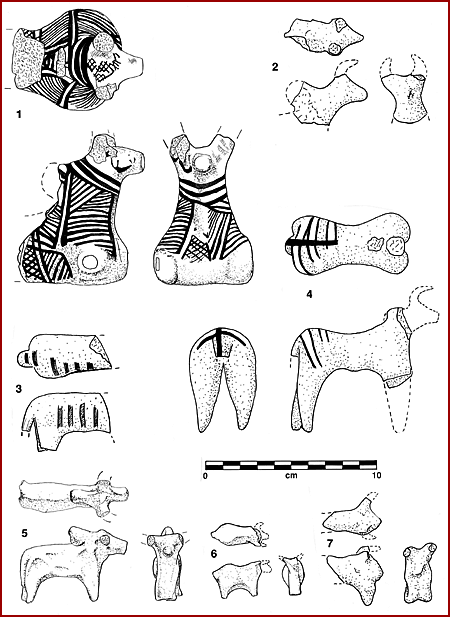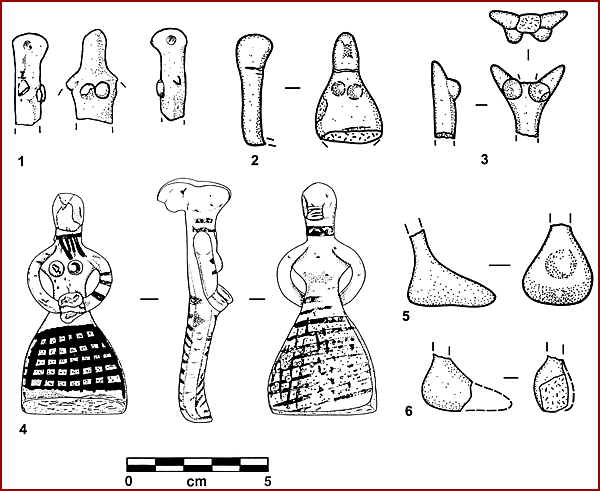Regionalization Era: Art and Symbol (cont.)
At Harappa, terracotta animal and human figurines become more common during the Kot Diji Phase and some of them have been found painted black or red designs. Some of the bull figurines have painted bands and stripes on their legs and hump (Figure 5).

Figure 5. Harappa: Ravi and Kot Diji Phase Animal Figurines.
1. Terracotta Bull Figurine: Kot Diji Phase, H96/7401-01
2. Terracotta Bull Figurine: Kot Diji Phase, H96/7467-41
3. Terracotta Bull Figurine with black paint: Kot Diji Phase, H96/7431-03
4. Terracotta Bull Figurine with black and white paint: Kot Diji Phase, H96/7402-65
5. Terracotta Bull Figurine: Kot Diji Phase, H96/7467-14
6. Terracotta Bull Figurine: Ravi Phase, H96/7490-05
7. Terracotta Bull Figurine: Ravi Phase, H96/7527-10
Ram figurines sometimes have holes to attach wheels so that they can be pulled as a toy. One human female figurine has a necklace with pendants painted around her neck and is wearing a skirt made with a plaid or checkered design (Figure 6).

Figure 6. Harappa: Kot Diji Phase Human Figurines.
1. Terracotta Female Figurine: Kot Diji Phase, H96/ 7423-1
2. Terracotta Female Figurine: Ravi/Kot Diji Pase, H98/8404-3
3. Terracotta Female Figurine: Ravi/Kot Diji Phase, H98/8439-3
4. Terracotta Female Figurine: Kot Diji Phase, H98-3456/8404-161
5. Terracotta Female Figurine: Kot Diji Phase, H98/8490-97
6. Terracotta Female Figurine: Kot Diji Phase, H98- 8532-5
It is important to note that there is much less variety in human figurine styles found at Harappa compared to sites such as Mehrgarh and Nausharo, where appliqué is an important technique used for decoration. In Harappa it is possible that fugitive pigments may have been used to decorate figurines. Such painting techniques are much faster than appliqué modeling, but are not often preserved archaeologically.
A detailed comparison of figurines and other finely crafted objects from Harappa and sites such as Mehrgarh/Nausharo has not been undertaken. However, it may provide important insights into the differences in social and ideological aspects of small and large settlements during this period of regional development.
Technology
At the site of Mehrgarh, production in the periods following the Neolithic (after 5500 BCE.) shows an increase in the importation and processing of non-local raw materials. During the Ceramic Neolithic and later Chalcolithic periods at Mehrgarh (Period III, around 4800 to 3300 BCE.) there is evidence for local production of soft stone beads such as steatite and limestone (Vidale 1989; Vidale 1995). Copper or stone drills were probably used on the softer materials. During this time we also see the earliest use of harder varieties of rock such as agate and jasper that were being perforated using specialized stone drills. Local manufacture of marine shell ornaments is also well established (Kenoyer 1995b). Both bead making and shell working involve non-local materials, several stages of production and more complex technological processes that may indicate the presence of m[re than one craft specialist. In addition to these exotic materials, the local potters and modelers had developed many styles of pottery and delicately modeled figurines of humans and animals (Jarrige 1988). The pottery firing was undertaken in updraft kilns as well as in large pit kilns for the production of large quantities of storage jars. At this point there is no indication of the types of kilns used for faience production at Mehrgarh/Nausharo or at Harappa. The presence of copper melting crucibles at Mehrgarh (Jarrige, Jarrige et al. 1995) indicates that this technology was being practiced at sites far from the original source of the raw materials (Kenoyer and Miller 1997).
All of the basic technologies used at Mehrgarh and Nausharo appear to be present at Harappa during the Early Harappan period. The major difference between these sites is the fact that at Harappa there is a long-term occupational continuity between the different periods, a gradual increase in the diversity of crafts and an increase in the overall scale of production. By the end of the Early Harappan period the site of Harappa has grown to over 25 hectares and is clearly divided into two mounds with massive mud brick perimeter walls around both parts of the site. Craft activities have been found in both of the mounds and include a wide variety of exotic materials and complex technologies. Steatite was being brought from distant resource areas and made into various types of beads, some of which were glazed. Steatite seals with script and animal motifs were carved and fired at the site. Numerous types of colored jasper, agate, carnelian and other varieties of rock were being brought in their raw form and made into beads and pendants. As mentioned above, the production of faience at Harappa represents a highly specialized technology that required the intensive processing of materials and firing at high temperatures to achieve a glassy, compact substance with a shiny bluegreen glaze. While faience is documented from Mehrgarh and also from Nausharo during this period, it is not known if it was made using the same techniques as found at Harappa. Finished copper tools and weapons have been found at Harappa, and it is assumed that some copper working was going on at the site, but so far no production areas have been excavated for the Early Harappan Phase. However, recent excavations of the Harappan Phase copper working areas (Meadow, Kenoyer and Wright 2000) and the large number of copper objects recovered from the earlier excavations provide strong evidence for a long tradition of copper and bronze working at the site (Kenoyer and Miller 1997).
